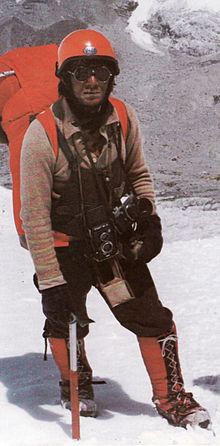Józef Jerzy Kukuczka (24 March 1948 – 24 October 1989) was a Polish mountaineer. He was born in Katowice, his family was ethnically Silesian Goral.[2] On 18 September 1987, he became the second man (after Reinhold Messner) to climb all fourteen eight-thousanders in the world; a feat which took him less than 8 years to accomplish. He climbed all, except Lhotse, by new routes or in winter. He is the only person to have climbed two eight-thousanders in one winter and his ascents of Cho Oyu, Kangchenjunga and Annapurna were first winter ascents.[3] His ascent of K2 was made in alpine style with Tadeusz Piotrowski, that route (the so-called "Polish Line") has not had a second ascent in over 35 years. Reinhold Messner, upon hearing that Kukuczka had completed all fourteen 8000ers, wrote to him: "you are not second you are great",[4] a line which is reproduced as the epigraph of Kukuczka book[5] and the polish translation forms the title of a biography published in 2021.[6]
 Jerzy Kukuczka on Mount Everest, 1980 | |
| Personal information | |
|---|---|
| Nationality | Polish |
| Born | 24 March 1948 |
| Died | 24 October 1989 (aged 41) |
| Website | Virtual Museum of Jerzy Kukuczka |
| Climbing career | |
| Known for |
|
| First ascents | Gasherbrum II East, Biarchedi, Manaslu East, Yebokalgan Ri, Shishapangma West |
| Major ascents | Four winter ascents on the eight-thousanders |


Eight-thousanders
Kukuczka is widely considered within the mountaineering community to be one of the best high-altitude climbers in history.[7] He ascended all fourteen eight-thousanders in seven years, 11 months and 14 days; he held the world record for shortest time span to summit the eight-thousanders for nearly 27 years until May 2014, when Kim Chang-ho beat his mark by one month and eight days.[8] Unlike many other prominent high-altitude climbers of his time, the routes Kukuczka chose on the Himalayan giants were usually original, many of them first ascents and often done in the grip of winter wind and cold.[9] During his career, Kukuczka established ten new routes on the eight-thousanders (still a record) and climbed four of them in winter. He was one of an elite group of Polish Himalayan mountaineers called Ice Warriors, who specialized in winter ascents.
In an era in Poland where even the most basic foods were scarce, Kukuczka was able to successfully mount and equip numerous expeditions to far-flung mountain ranges. Usually pressed for cash and equipment, he painted factory chimneys by rope access (industrial climbing) to earn precious złotys to finance his mountaineering dreams.[9]
| Year | Location | Mountain | Route | Comments |
|---|---|---|---|---|
| 1979 | Nepal | Lhotse | West Face | Normal Route |
| 1980 | Nepal | Mount Everest | South Pillar | New Route[10][5] |
| 1981 | Nepal | Makalu | Variation to Makalu La/North-West Ridge | New Route, Alpine style, Solo |
| 1982 | Pakistan | Broad Peak | West Spur | Normal Route, Alpine style |
| 1983 | Pakistan | Gasherbrum II | South-East Spur | New Route, Alpine style |
| 1983 | Pakistan | Gasherbrum I | South-West Face | New Route, Alpine style |
| 1984 | Pakistan | Broad Peak | Traverse of North, Middle, Rocky and Main Summits | New Route, Alpine style |
| 1985 | Nepal | Dhaulagiri | North-East Spur | Normal Route, First Winter Ascent[11][12] |
| 1985 | Nepal | Cho Oyu | South-East Pillar | Second Winter Ascent |
| 1985 | Pakistan | Nanga Parbat | South-East Pillar | New Route[13] |
| 1986 | Nepal | Kanchenjunga | South-West Face | Normal Route, First Winter Ascent[14][5] |
| 1986 | Pakistan | K2 | South Face | New Route, Alpine style[15] |
| 1986 | Nepal | Manaslu | North-East Face | New Route, Alpine style |
| 1987 | Nepal | Annapurna I | North Face | Normal Route, First Winter Ascent[16] |
| 1987 | China | Shishapangma | West Ridge | New Route, Alpine style, Ski Descent |
| 1988 | Nepal | Annapurna East | South Face | New Route, Alpine style |
He climbed all summits, except for Mount Everest, without the use of supplemental oxygen.
Death
Kukuczka died while attempting to climb the unclimbed South Face of Lhotse in Nepal on 24 October 1989. He was leading a pitch at an altitude of about 8,200 metres (26,900 ft) on a 6 mm secondhand rope he had picked up in a market in Kathmandu. According to Ryszard Pawłowski, Kukuczka's climbing partner, the main single rope used by the team was too jammed to be used and the climbers decided to use transport rope instead. When Kukuczka lost his footing and fell, the cord was either cut or it snapped, plunging him around 2,000 metres to his death. His body was never found.
Commemoration
In the hamlet of Wilcze in Istebna in the highlander's summer house Jerzy Kukuczka, there is the Memorial Chamber of Jerzy Kukuczka, created in 1996 by Cecylia Kukuczka (Jerzy's wife).
The mountain "Yak Hotel" in Nepal in Dingboche (4400 m a.s.l.) is named after Jerzy Kukuczka.
The Jerzy Kukuczka Academy of Physical Education is a public university in Katowice that conducts teaching and research in physical education and rehabilitation.[17]
There is also a street in the Gaj district in Wrocław named after him.
- Monument in Katowice
- Jerzy Kukuczka's memorial with Lhotse in the background
- Memorial plaque in Istebna
- Monument of Polish mountaineers in Katowice
See also
Bibliography
- Kukuczka, Jerzy (1992). My Vertical World: Climbing the 8000-Metre Peaks. Mountaineers Books. p. 189. ISBN 0-89886-344-9.[5]
- Wąsikowski, Piotr (1996). Dwa razy Everest. PiT.
- Kukuczka, Jerzy (1990). Na szczytach swiata. Krajowa Agencja Wydawnicza. p. 193. ISBN 83-03-03166-X.
- Gasca, Gian Luca (2021). Nie jesteś drugi jesteś wielki. Włoski portret Jerzego Kukuczki. Fundacja Wielki Czlowiek. ISBN 9788365095053.[18]
References
External links






